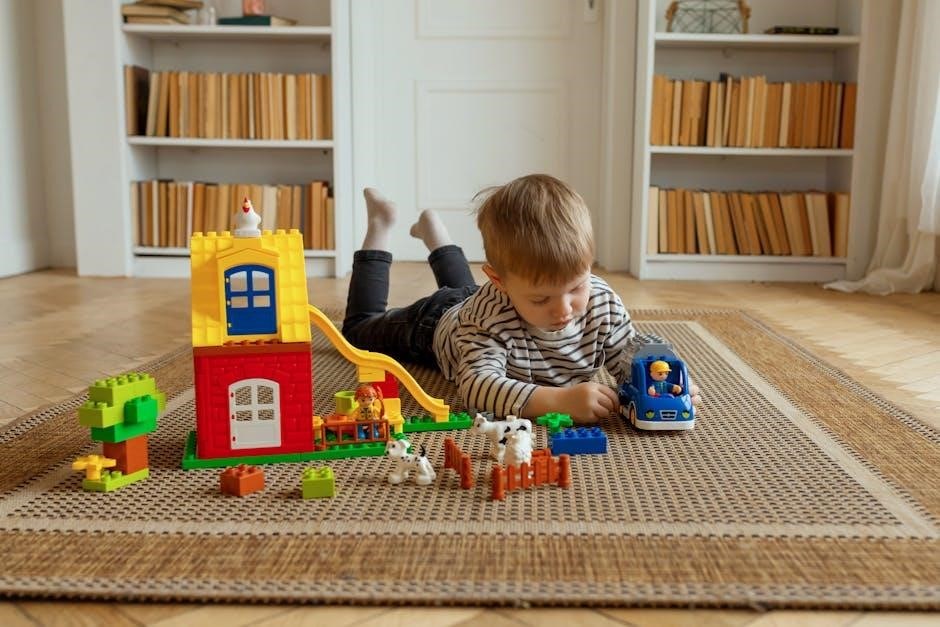Welcome to our comprehensive guide on Lego Venator instructions. This guide provides step-by-step instructions, tips, and tricks for building this iconic Star Wars Republic Attack Cruiser model. Whether you’re a seasoned builder or a novice, this guide will help you navigate the complexities of this intricate set. Learn how to manage large kits, avoid common mistakes, and create stunning custom builds; Perfect for solo projects or family fun, this guide ensures a smooth and enjoyable building experience.
1.1 Overview of the Lego Venator Set
The Lego Venator Set is a highly detailed and intricate representation of the Republic Attack Cruiser from the Star Wars universe. Designed for experienced builders, this set features a large-scale model with complex architecture and numerous components. Its impressive size, often reaching over 10 feet in length for custom builds, showcases the ship’s imposing presence. The set includes detailed sections such as the command bridge, hangar bays, and turbo-laser cannons, offering a mix of structural complexity and aesthetic appeal. Builders can explore advanced techniques to modify the model for screen accuracy or create custom designs using tools like Stud.io. With its rich details and versatility, the Venator Set is a beloved choice for both Star Wars fans and Lego enthusiasts, providing a challenging yet rewarding building experience.
1.2 Importance of Following Instructions
Following the Lego Venator instructions is crucial for a successful and enjoyable building experience. The intricate design and numerous components require precision to ensure all parts fit correctly. Deviating from the guide can lead to structural issues or misplaced details, potentially ruining the model’s integrity. The instructions provide a clear roadmap, helping builders manage the complexity of the set. By adhering to the steps, you minimize errors and ensure a polished final product. Additionally, the guide helps in understanding the model’s architecture, making it easier to troubleshoot if problems arise. Whether building solo or with kids, following the instructions enhances the overall experience, leading to a sense of accomplishment and pride in your completed Venator.
1.3 Brief History of the Lego Venator
The Lego Venator, a replica of the Star Wars Republic Attack Cruiser, has a rich history in Lego’s portfolio. First introduced in 2009 as part of the Star Wars line, it quickly gained popularity among fans for its detailed design and faithfulness to the source material. Over the years, Lego has released updated versions, with the latest being the Ultimate Collector’s Series (UCS) edition, offering even greater complexity and accuracy. Builders and collectors alike praise the Venator for its intricate build process and iconic status, making it a standout piece in any Lego Star Wars collection. Its enduring appeal lies in its blend of nostalgia and innovative design, captivating both seasoned enthusiasts and newcomers.


Understanding the Lego Venator Instructions
Mastering the Lego Venator instructions requires attention to detail and organization. The manual is divided into clear sections, guiding you through each phase of construction; Symbols and notations are crucial for identifying parts and actions. Utilize digital tools like Stud.io for visualizing complex steps. Ensure all necessary tools and resources are within reach to streamline your building process. This section equips you with the knowledge to decipher the instructions effectively, setting a solid foundation for a successful build. With patience and the right approach, you’ll navigate the instructions with confidence, bringing your Venator to life seamlessly.
2.1 Structure of the Instruction Manual
The Lego Venator instruction manual is meticulously organized to guide builders through the complex assembly process. It begins with a detailed parts list, ensuring builders can prepare and organize components in advance. The manual is divided into logical sections, starting with the main hull assembly, followed by wings, engines, and final details. Each step is illustrated with clear visuals, often highlighting specific parts and their placement. Symbols and color-coded diagrams help differentiate components, while numbered bags correspond to specific stages. For digital users, interactive 3D models and step-by-step animations enhance understanding. Tips for managing large kits, such as dividing tasks, are also included. By following this structured approach, builders can efficiently navigate the instructions, ensuring a smooth and enjoyable construction experience. Understanding the manual’s layout is key to mastering the Venator’s intricate design.
2.2 Key Symbols and Notations
The Lego Venator instructions utilize a variety of symbols and notations to guide builders effectively. Common symbols include part numbers, color codes, and assembly directions. Arrows indicate placement orientation, while highlighted elements show where parts connect. A wrench symbol denotes the need for tools, and shaded backgrounds mark completed sections. Numbered bags correspond to specific stages, helping builders organize components. Some manuals feature a legend explaining these symbols, ensuring clarity. Paying attention to these notations is crucial for accuracy, especially in complex sections like the wing assembly or engine details. By familiarizing yourself with these symbols, you can navigate the instructions seamlessly and avoid errors. Proper understanding of these visual cues is essential for a smooth and enjoyable building experience with the Lego Venator.

2.3 Tools and Resources Needed
Building the Lego Venator requires specific tools and resources to ensure a smooth experience. Essential tools include an Allen wrench for tight connections and a stud remover for safely detaching parts. A digital copy of the instructions, often available on Lego’s website, can provide zoomed-in views for clarity. Organizing parts by bag number or type is crucial, especially for large kits. Additionally, software like Stud.io can help visualize and modify designs, while BrickLink allows users to create and manage parts lists. Having a clean workspace and storage solutions, such as sorting trays, is also recommended. These tools and resources will help you stay organized and tackle the build with confidence. Proper preparation ensures a more enjoyable and efficient building process for the Lego Venator.

Building the Lego Venator
Constructing the Lego Venator involves a detailed, step-by-step process. Start by organizing parts and following the manual’s guidance. Manage large kits by dividing tasks, and use tools like Stud.io for customization. Troubleshoot errors early and consider modifications for screen accuracy. Patience and organization are key to successfully assembling this intricate model.
3.1 Step-by-Step Guide to Assembly
Begin by organizing parts and following the instruction manual systematically. Start with the base structure, ensuring alignment and stability. Pay attention to intricate details like the hull and wing sections, which require precision. Use tools like Stud.io for visual guidance, especially for complex areas. Divide tasks into manageable sections, focusing on one area at a time. For the wings, trial and error may be necessary to achieve the perfect fit. Regularly verify each step to avoid misalignments. If stuck, consult online resources or Lego support. Keep all parts sorted to maintain efficiency. By following these steps, you’ll navigate the assembly process smoothly and enjoy the satisfaction of building this iconic model.
3.2 Tips for Managing Large Kits
Managing large Lego kits like the Venator requires organization and patience. Start by sorting parts by type or color to streamline assembly. Break the project into smaller sections, focusing on one area at a time to avoid overwhelm. Use tools like Stud.io for visual guidance, especially for complex components. Regularly check your work to ensure accuracy and address any issues early. If building with others, adopt a “divide and conquer” approach, assigning tasks to team members. Keep a dedicated workspace clean and label parts containers for easy access. Schedule breaks to maintain focus and motivation. By staying organized and methodical, you’ll navigate even the largest kits with confidence and efficiency.
3.3 Common Mistakes to Avoid
When building the Lego Venator, common mistakes include misaligning parts, skipping steps, and not double-checking connections. Ensure all pieces are securely attached before moving to the next section. Pay close attention to symmetry, especially in wing assemblies, as errors here can throw off the entire model. Avoid forcing pieces into place, as this can damage bricks or the finished structure. Regularly review your progress to catch mistakes early. Miscounting or misplacing small parts, like studs or tiles, is another frequent issue. Use tools like Stud.io for clarity, and consider sorting parts by type to reduce confusion. Patience and organization are key to avoiding these pitfalls and achieving a flawless build.
3.4 Tricks for Smoother Construction
To ensure a smoother Lego Venator construction, start by organizing your parts into categories or bags as indicated in the manual. Use digital tools like Stud.io to visualize complex sections before assembly. Divide large tasks into smaller, manageable steps, especially if building with others. For instance, one person can focus on the hull while another works on the wings. Regularly double-check your work against the instructions to avoid costly mistakes. Keep your workspace clean and use a sorting tray to easily locate small pieces. Finally, don’t hesitate to take breaks—approaching the build with a fresh perspective often leads to better results. These strategies will help you maintain momentum and enjoy the process of creating this iconic starship.

Advanced Techniques for Custom Builds
Explore advanced techniques for customizing your Lego Venator. Use software tools for precise modifications and unique designs. Modify for screen accuracy, enhance Star Wars UCS appeal. Create a parts list with BrickLink, organize pieces, and maintain efficiency while personalizing your build.
4.1 Modifying the Venator for Screen Accuracy
Enhance your Lego Venator’s authenticity by modifying it for screen accuracy. Reference official Star Wars designs to replicate details like turbo-laser cannons and hanger bay interiors. Adjust colors and shapes to match the on-screen appearance. Utilize BrickLink to source additional or alternate parts. Follow community tutorials or software guides for precise adjustments. Ensure modifications align with the original set’s structure while adding unique touches. This approach elevates your build from a toy to a faithful replica, perfect for display or gifting. Achieve a professional finish by refining every detail meticulously.
4.2 Using Software for Custom Designs
Take your Lego Venator to the next level with custom designs using software tools like Stud.io or Lego Digital Designer. These programs allow you to visualize and modify your build digitally before assembling it physically. Create detailed 3D models, experiment with color schemes, and test structural integrity virtually. Import official instructions or design from scratch, ensuring accuracy and precision. Use these tools to plan complex modifications, such as adding screen-accurate details or unique features. Once satisfied, generate a parts list and order missing elements via BrickLink. This method streamlines the customization process, making it easier to achieve your vision. Perfect for enthusiasts seeking a personalized touch, software design enhances creativity and efficiency in building your Venator.

4.3 Creating a Parts List with BrickLink
Creating a parts list with BrickLink is essential for managing your Lego Venator project; Start by importing your custom design into BrickLink’s Studio software, which generates a detailed inventory of required parts. This feature ensures you identify all necessary components, including rare or specialized pieces. Once your list is ready, BrickLink allows you to check off items you already own and purchase missing parts directly from sellers. This streamlined process helps avoid shortages and reduces errors during assembly. Additionally, BrickLink’s marketplace offers a wide selection of new and used Lego elements, making it easier to source hard-to-find pieces. By organizing your parts list effectively, you can focus on building your Venator with confidence and precision, ensuring a successful and enjoyable project.

Troubleshooting and Repair
Troubleshooting and repair are crucial for resolving issues during your Lego Venator build. Identify errors early, address missing or damaged parts, and contact Lego support if needed for assistance.
5.1 Identifying and Fixing Errors
Identifying and fixing errors during your Lego Venator build is essential for achieving a flawless final product. Start by carefully reviewing each step in the instructions to ensure all components are correctly aligned and secured. Common mistakes include misplacing bricks or misconnecting sections, which can lead to instability or aesthetic issues. If you encounter a problem, consult the instruction manual or online resources for clarification. Tools like Stud.io can help visualize tricky parts, while online forums offer tips from experienced builders. Remember, patience is key—taking the time to address errors now will save frustration later and result in a professional-looking model.
5.2 Handling Missing or Damaged Parts
If you discover missing or damaged parts during your Lego Venator build, remain calm and follow a systematic approach. First, double-check your inventory against the instruction manual to confirm the parts are indeed missing. For damaged pieces, assess whether they can be repaired or if replacement is necessary. Contact Lego customer support for assistance with missing or damaged components—they often provide replacements free of charge. Additionally, platforms like BrickLink allow you to purchase individual parts if needed. Before reaching out, ensure you’ve thoroughly checked your build area, as small parts can easily be misplaced. If a part is damaged, carefully remove it and set it aside for replacement. This proactive approach ensures your build stays on track and maintains its integrity.
5.3 Contacting Lego Support
If you encounter issues with missing or damaged parts while building your Lego Venator, contacting Lego Support is a reliable solution. Lego customer service is known for its helpfulness and can provide replacements for missing or damaged pieces. Visit the Lego website, navigate to the support section, and fill out the contact form or use the live chat feature. Be prepared to provide details like your set number, part number, and order information; For quicker assistance, ensure you have these details ready. If you prefer, you can also contact Lego Support via phone or email. Remember, Lego often resolves such issues promptly, so don’t hesitate to reach out. This ensures your build continues smoothly without delays.

Building with Kids
Building the Lego Venator with kids fosters creativity and teamwork. Assign age-appropriate tasks, encourage collaboration, and celebrate progress. Make it a fun, family bonding experience.
6.1 Strategies for Collaborative Building
Collaborative building with kids requires clear communication and organization. Start by dividing tasks based on skill levels—adults can handle complex sections, while kids focus on simpler parts. Use visual aids like instruction manuals or digital tools to guide young builders. Encourage teamwork by assigning specific roles, such as sorting pieces or assembling smaller modules. Create a shared workspace where everyone can contribute, fostering a sense of ownership and camaraderie. Teach problem-solving by letting kids attempt steps independently, offering help only when needed. Celebrate progress to keep motivation high. By breaking the project into manageable steps, you ensure a fun and educational experience for all participants.
6.2 Teaching Kids to Follow Instructions
Teaching kids to follow Lego instructions involves patience and clear guidance. Begin by introducing the concept of step-by-step building, using visual aids like instruction manuals or digital tools. Break down complex steps into simpler tasks, encouraging kids to focus on one section at a time. Demonstrate how to identify and match pieces, fostering problem-solving skills. Encourage hands-on practice, guiding them through initial steps before letting them attempt on their own. Praise their efforts to build confidence and motivate them to continue. Teach them to recognize symbols and notations, helping them understand the language of Lego instructions. By making the process interactive and fun, you help kids develop essential skills while enjoying the creative journey of building the Venator together.

6.3 Making It a Fun, Family Activity
Transforming the Lego Venator build into a family activity fosters bonding and creativity. Encourage teamwork by dividing tasks among family members based on skill levels. Let younger kids sort pieces while older ones focus on complex sections. Use tools like Stud.io to visualize the build together, making it interactive and engaging. Celebrate small milestones to keep morale high. Turn it into a game by setting timers or challenging family members to complete sections. Emphasize the joy of collaboration and problem-solving. This shared experience not only creates lasting memories but also teaches patience and attention to detail. Make it a special event with snacks, music, or themed Star Wars movies playing in the background. The sense of accomplishment upon completion will be a rewarding experience for all ages.
Completing the Lego Venator is a rewarding journey, blending creativity and precision. This guide helps you navigate challenges, ensuring a successful and enjoyable building experience from start to finish.
7.1 Final Tips for Success
As you complete your Lego Venator, remember to stay organized and patient. Divide complex sections into smaller tasks to maintain focus. Use digital tools like Stud.io to visualize builds and manage parts efficiently. Regularly double-check your work to avoid mistakes. If unsure, consult online forums or Lego support for guidance. For custom builds, BrickLink can help source additional parts. Collaborative efforts, especially with children, foster creativity and teamwork. Celebrate each milestone, and don’t hesitate to seek help when needed. With persistence and joy, your Venator will be a masterpiece, showcasing your dedication and skill in Lego craftsmanship.
7.2 The Joy of Creating with Lego
Building the Lego Venator is more than just assembling pieces; it’s a creative journey that sparks joy and fulfillment. Seeing your hard work come to life is incredibly rewarding. The process fosters patience, problem-solving, and attention to detail. Collaborating with others, especially children, adds a layer of shared excitement and learning. Lego building is a timeless hobby that connects generations and brings people together. The satisfaction of completing a complex model like the Venator is a testament to dedication and creativity. It’s a reminder that building with Lego is not just about the final product but the enjoyable process of creating something truly special.
